Menus
- Inconspicuous over the distance
- Other tires bring a lot
- Only minor defects
- Only a shift fork worries
- Suzuki comments
- Reading experiences
- Used Suzuki GSX-S 1000 F at a glance
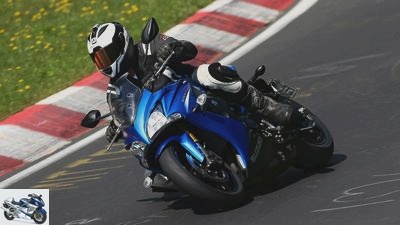
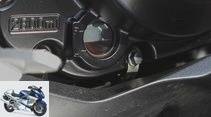

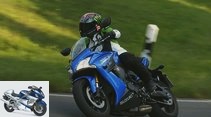
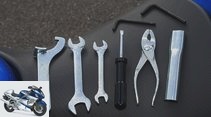
46 photos
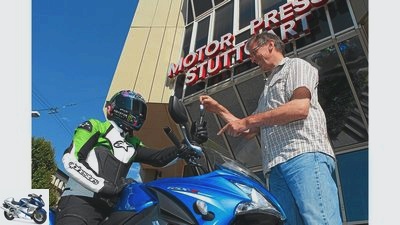
Bilski
1/46
“Can you still handle 151 hp and 106 Newton meters? In any case, leave the traction control in, ”warns test boss Thole to the returnee.
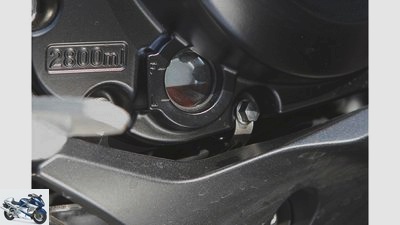
Bilski
2/46
After 2000 kilometers, the engine oil still shimmers like on the first day. After the upcoming compression measurement, the engine is sealed.
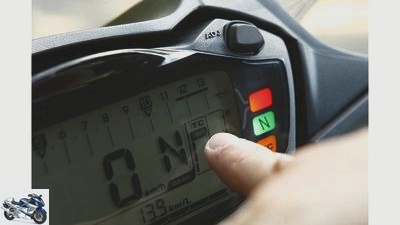
Bilski
3/46
Suzuki GSX-S 1000 F with three-stage traction control.
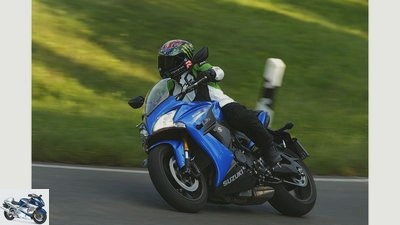
Bilski
4/46
“Awesome oven with great handling” is what the editorial team says.
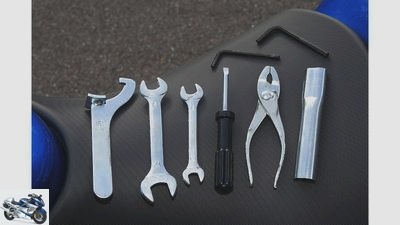
Bilski
5/46
Praiseworthy: The on-board tools are sufficient, at least it has a hook wrench for adjusting the strut.
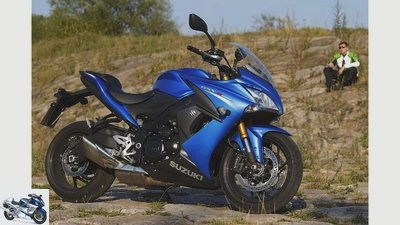
Bilski
6/46
The ex-editor hopes to be able to cover some of the upcoming 48,000 kilometers with the GSX-S 1000 F..

Mo-To
7/46
Motorhome: Norway and its fjords were the goal.
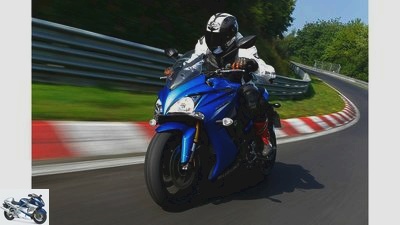
www.factstudio.de
8/46
Flott: The Suzuki has also seen the Nordschleife.
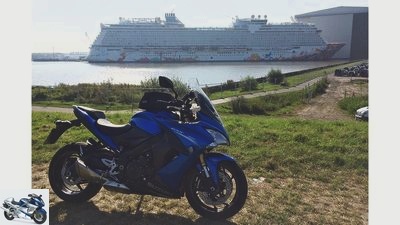
Mo-To
9/46
Everyday escape mobile: With small luggage on the Ems…
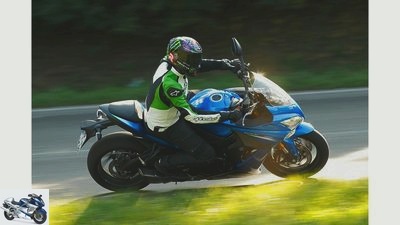
www.bilski-fotografie.de
10/46
…or in the bankruptcy frenzy…

www.factstudio.de
11/46
…on the editors’ home routes.
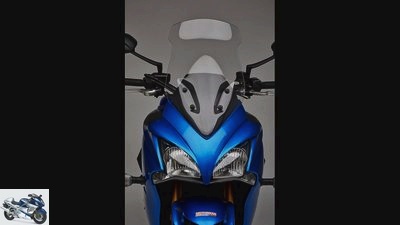
mps photo studio
12/46
Tall Suzuki windshield: Maybe not the first choice in terms of looks, but the function is impressive.
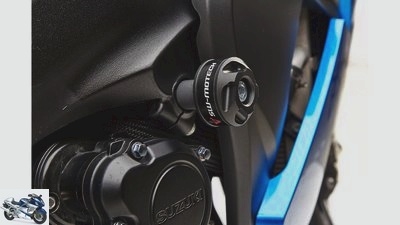
mps photo studio
13/46
Crash pads from SW-Motech, which are supposed to protect the fairing from scratches in the event of a slip.
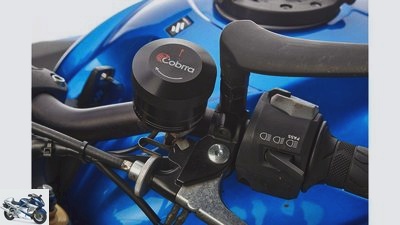
mps photo studio
14/46
Manual chain oiler Nemo2 from Kruger Moto-Parts, which presses lubricant to the chain by turning the cover.
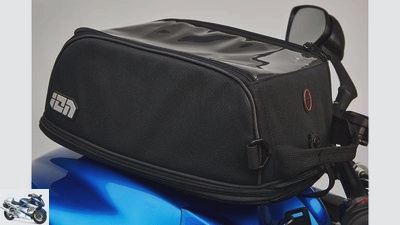
mps photo studio
15/46
Quick-Lock tank bag ION two from SW-Motech…
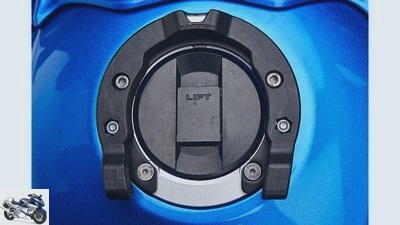
mps photo studio
16/46
…including a matching adapter ring. With a volume of 13 to 20 liters, well suited for trips of all kinds.
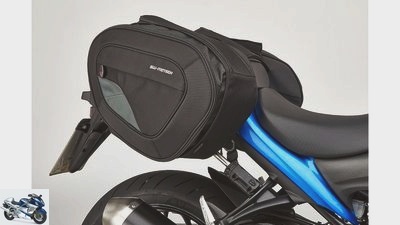
mps photo studio
17/46
The Blaze saddlebags are also from SW-Motech,…
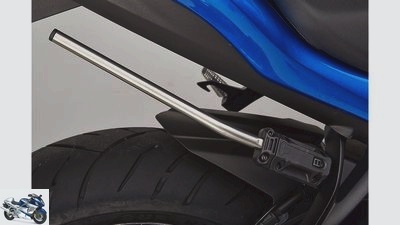
mps photo studio
18/46
…which are attached to the rear of the Suzuki GSX-S 1000 F using a removable spacer bracket.
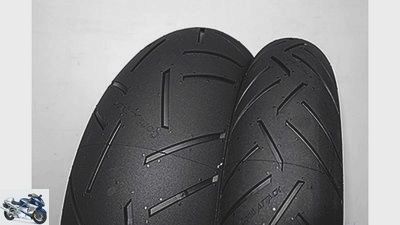
Karsten Schwers
19/46
Continental SportAttack 3: After a few meters, the Conti gives you a perfect feeling for grip. Very handy and neutral, it steers the Suzuki GSX-S 1000 F into an inclined position and delivers a lot of grip up to deep inclines. It scores with low erection torque and very good straight-line stability. Only when it is wet is it not quite on the level of touring tires. The recommendation for speedy Suzuki pilots.
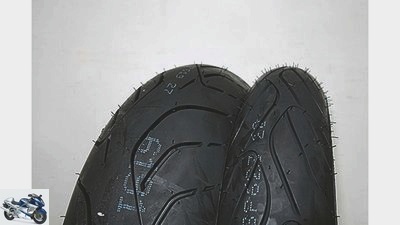
Karsten Schwers
20/46
Dunlop Roadsmart 3: Compared to the standard tires, the Roadsmart 3 provides better feedback on grip. He gives in more easily and neutrally. At top speed, however, not as stable as the standard tires. It has almost no righting moment when braking in an inclined position, combines low steering forces with good grip – even in the wet. Much more recommendable than the series tires of the Suzuki GSX-S 1000 F..
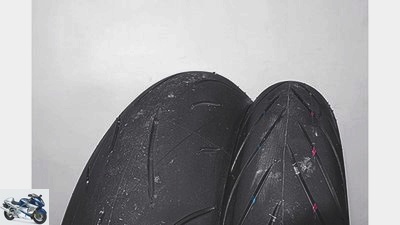
Karsten Schwers
21/46
Dunlop Sportmax D 214: The standard tires are pleasing with good straight-line stability, but have little feedback and self-damping when cold. When brought up to temperature, the D 214 still does not reach the balanced level of Roadsmart 3. It also always wants to be tilted with emphasis. Recommended: For example, switch to Roadsmart 3 when replacing.
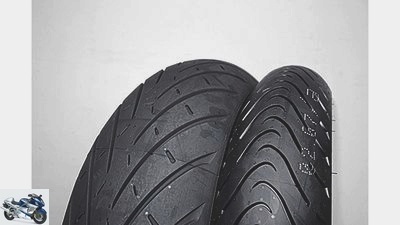
Karsten Schwers
22/46
Metzeler Roadtec 01: The Metzeler convinces with good feedback for the grip, is more manageable than the series tires of the Suzuki GSX-S 1000 F, albeit a touch behind the Roadsmart 3. Its straight-line stability is exemplary. Although its righting moment when braking in an inclined position is somewhat greater than with the Roadsmart 3, it scores in the wet with the best feedback and grip.
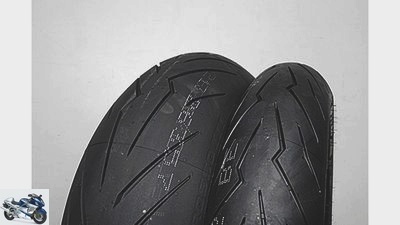
Karsten Schwers
23/46
Pirelli Diablo Rosso III: The Pirelli wants to be warmed up, then the feedback, grip and agility are right. Its erection moment when braking in an inclined position is slightly greater than that of the Conti. The Rosso III can only show its qualities at increasing speed. At a brisk pace, extremely stable with exemplary straight-line stability. The wet grip is absolutely fine for a sports tire.
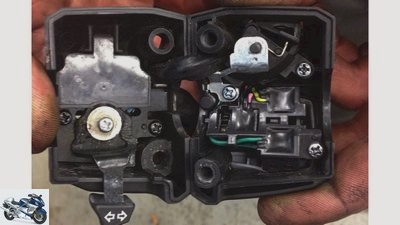
mps photo studio
24/46
During the long-term test of the Suzuki GSX-S1000 F, the left handlebar switch was defective.
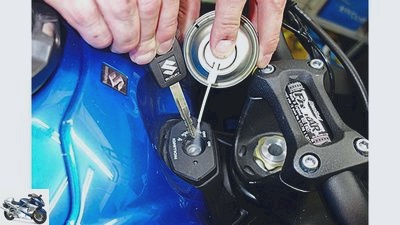
Mo-To
25/46
There was another defect in the steering lock.
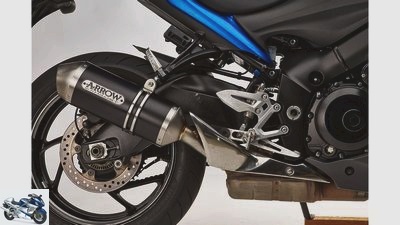
mps photo studio
26/46
Arrow Dark Race Tech: The series exhaust of the Suzuki GSX-S 1000 F follows the trend towards small stub pots, which are possible thanks to the upstream collector. Those who are bothered by this will find an alternative with the Arrow damper. The Arrow, which is available for 385 euros, weighs 2.4 kilograms, however, 300 grams more than the standard pot and costs almost the entire speed range. Because the clamp is attached to the right passenger peg, assembly is not that easy. The sound of the Arrow, which is more reserved than the original, is extremely socially acceptable.
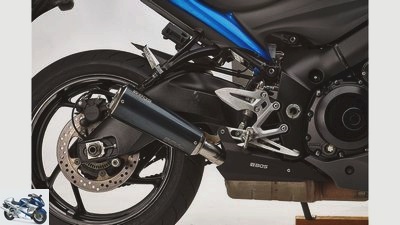
mps photo studio
27/46
Bos Carbon Steel SSEC RR: The Bos silencer on the Suzuki GSX-S 1000 F with its distinctive, barred outlet adds a little MotoGP flair. It undercuts the original pot in weight by 600 grams and is on the level of the series system in terms of performance. In terms of sound technology, it spices up the exhaust noise, which is already dominant as standard, with an audible bass tone, and sounds a little more present and powerful than the original silencer. The installation of the Bos, which costs 449 euros, including the new cover between the collector and the exhaust, is easy and the finish is convincing.
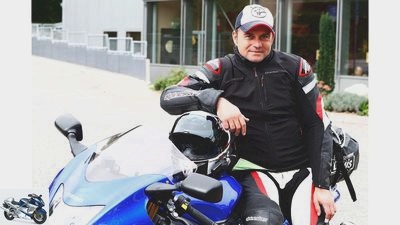
www.factstudio.de
28/46
Tobias Wassermann, Fleet Manager: “A partner in the best sense”
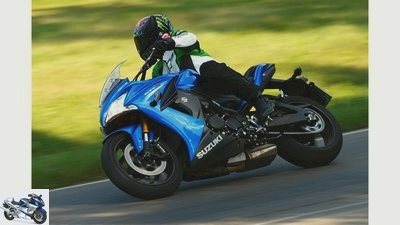
www.bilski-fotografie.de
29/46
Collect kilometers in comfort or quickly scrape the curve, the Suzuki GSX-S 1000 F can do both.
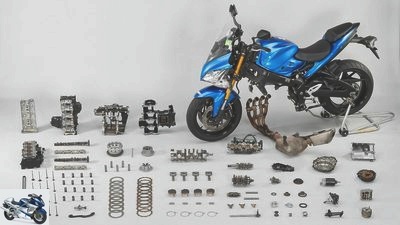
bilski-fotografie.de
30/46
Endurance test final balance Suzuki GSX-S 1000 F
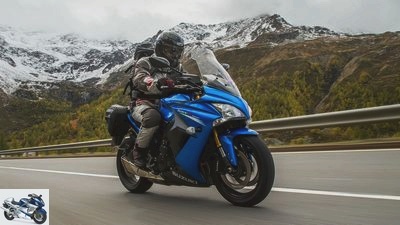
Arturo Rivas
31/46
The GSX-S 1000 F was in great demand as a motorhome – regardless of whether it was in the foothills of the Alps …
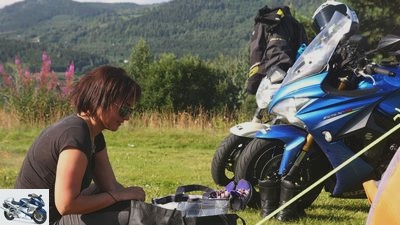
Moller-Tollner
32/46
… or as a reliable partner on a trip to Northern Europe to Norway.
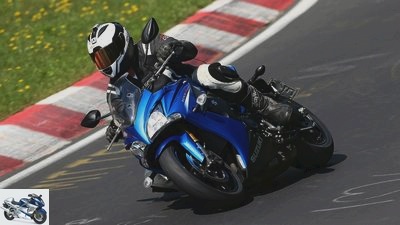
33/46
She was able to prove her sporting talents on the Nordschleife, among other places.
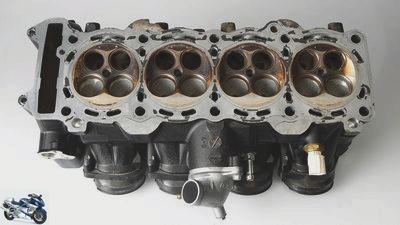
bilski-fotografie.de
34/46
Minor deposits on exhaust valves and combustion chambers, everything in the frame.
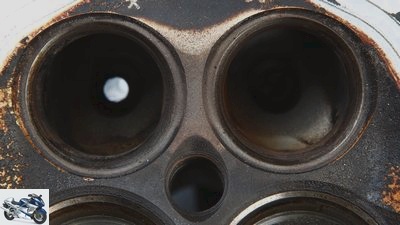
bilski-fotografie.de
35/46
After re-grinding in order to eliminate the minor leaks, the valves can all be put back in their seats.
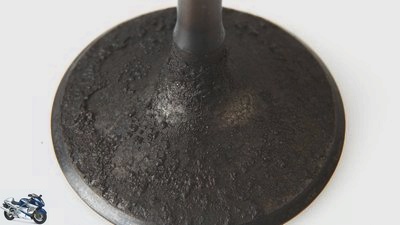
bilski-fotografie.de
36/46
Endurance test final balance Suzuki GSX-S 1000 F.
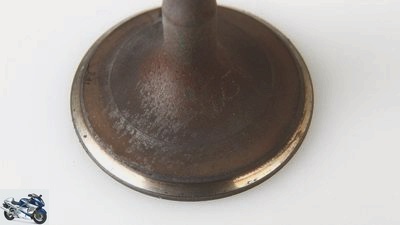
bilski-fotografie.de
37/46
Endurance test final balance Suzuki GSX-S 1000 F.
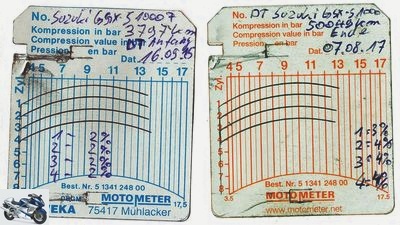
MOTORCYCLE
38/46
After 50,000 km, the pressure loss test reveals slightly lower values - without any impact on the performance of the 1000 series.
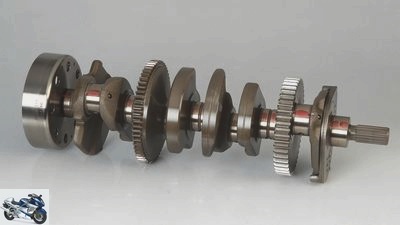
bilski-fotografie.de
39/46
The tracks on the main bearings show that the engine was in operation. But nothing more.
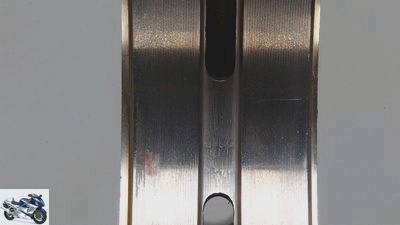
bilski-fotografie.de
40/46
The parts can be put back into the engine during assembly and are still good for many 10,000 kilometers.
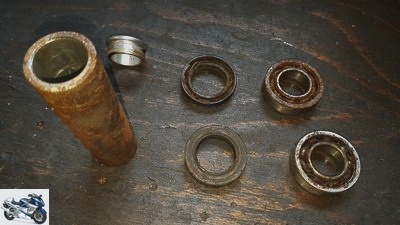
Gerry Wagner
41/46
After 42,000 kilometers, the front wheel bearing was at the end. Suzuki suspects a damaged seal as the cause.

bilski-fotografie.de
42/46
The clutch springs have only set a little and are within the operating tolerance. The slight chatter marks on the coupling core are harmless and have no effect on the function.
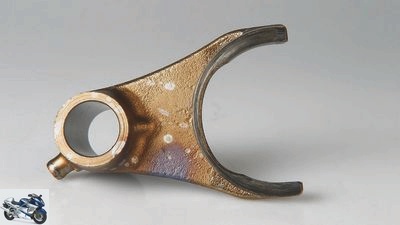
bilski-fotografie.de
43/46
A shift fork shows significant wear and is the only component that needs to be replaced.
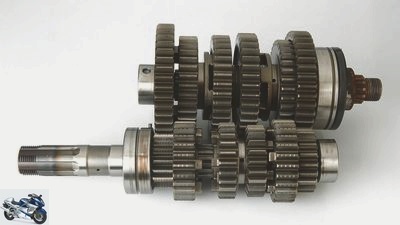
bilski-fotografie.de
44/46
The transmission left the long-term test distance completely unimpressed. Shift claws okay, tooth flanks perfect.
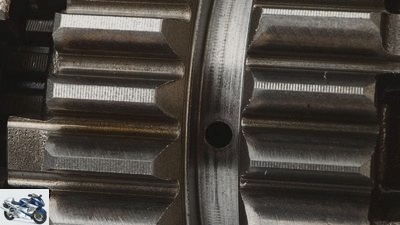
bilski-fotografie.de
45/46
Even between third and fourth gear, where the worn shift fork worked, no damage can be seen.

bilski-fotografie.de
46/46
Little need for discussion: the Suzuki men Kroschel, Plaschka, Steinmann (from left) and Muller (right) examining the engine.
Suzuki GSX-S 1000 F in the 50,000 km endurance test
Inconspicuous over the distance
With the Suzuki GSX-S 1000 F, Suzuki has a formidable fast-forward nude in its range. The enthusiastic fans of potent four-cylinder and has also provided a lot of joy in the endurance test. This remains after the four-thousandth is on the dissection table?
GIn many cases, rumors do not arise by chance. Often there is some truth in them, if the most daring assertion can be given a glimmer of reality. So if you cheekily call out that Japanese motorcycles are pretty reliable per se, you are probably not saying anything completely wrong. For which there is even evidence. The MOTORRAD endurance test is one of them. Seven Japanese makes are among the top ten motorcycles on the long-term test hit list. The series is led by the Yamaha MT-07. And the Suzuki GSX-S 1000 F, which is now in focus, is similar to the Yamaha. It has – and this is meant in an extremely positive way – pushed to the service without complaint. Regardless of whether she kidnapped her colleagues as far as Norway, raced over the Nordschleife, cycled alpine passes or simply commuted between work and home, the strong nude was never noticed.
Buy complete article

Suzuki GSX-S 1000 F in the 50,000 km endurance test
Inconspicuous over the distance
Row fours with hard throttle response
www.bilski-fotografie.de
The hard throttle response annoyed many drivers.
When full-throttle testers, who have almost every motorcycle under their bum, let themselves be carried away to such adulation, then that means something. But to be fair, it must be said that the engine not only impressed, but also stubbornly put the drivers’ nerves to the test at one point or another. Much more often than words of homage are entries in the logbook on the harsh, direct response behavior and constant jerking of the Suzuki. She has both to a large extent, both remained in place for the full 50,000 km, and both can be found as a negative aspect in almost all reader letters. Already after 4,000 km, the author complains that the response behavior when applying the gas at the apex of the curve hails the line, and the constant jerking when swimming in the commuting at low speeds in high gears is annoying. These tips run like a red thread through the entire endurance test.
Suzuki is not unfamiliar with the subject of constant speed jolts. To mitigate this, a new engine control unit was specially launched that can be retrofitted. For our long-term tester, however, this hint, which was only given at the final meeting, came too late. He reeled off the entire distance with the old control unit.
In order to classify the impressions expressed by the test drivers, one has to say that the Suzuki was driven almost without exception by drivers who change their vehicle every day. Therefore, their slightly rough nature is immediately noticeable. Anyone who has been continuously moving the strong four for a longer period of time will quickly come to terms with the not quite so finely honed manners of the engine. The bottom line is that it would work better, but by no means spoil the driving pleasure with the powerful Suzuki.
Other tires bring a lot
www.factstudio.de
All alternative tires were better than the original equipment.
This benefits most clearly from changing the tires. The original Dunlop D 214 run steadily in a straight line, but provide little feedback and make the four-cylinder more stubborn than handy. Alternatives were already presented in the interim report. The summary: Regardless of whether Contis Sport Attack 3, Dunlops Roadsmart 3, Metzelers Roadtec 01 or Pirellis Diablo Rosso III – they all offer better performance than the original tires.
Dunlop Roadsmart 3 and Metzeler Roadtec 01 have proven to be real marathon tires in the endurance test. Both of them easily put up with mileage of 10,000 kilometers on the rear tires in everyday life, the front tires even a few kilometers more. In terms of tire wear, the Suzuki is only slightly above the barely half as strong MT-07 from Yamaha, the current top of the long-term test hit list. The fact that it does not come close to the very good values of the two-cylinder from Hamamatsu in terms of costs is not surprising given the significant increase in cylinder, displacement and power. On the other hand, the fact that the gap to the small Yamaha is not that big is more surprising. Whereby this more can be well established in two exemplary points. Number one: consumption. With an average of 5.4 liters, the Suzuki is reasonably frugal, but the Yamaha needed even less with 4.4 liters. And that adds up to the 50,000 kilometer distance. For less than 3,100 euros, fuel had to go into the MT-07, the GSX-S 1000 F had more than 3,700 euros. And then there are the inspection requirements from the importer. The MT-07 only asked for new spark plugs twice. Makes four pieces for 50,000 km for the two-cylinder. The Suzuki has to be replaced more often, which is why it received a total of 16 new spark plugs. With a rounded unit price of 14.50 euros, these are expensive. And the higher operating costs are already explained to a certain extent.
Only minor defects
mps photo studio
During the long-term test of the Suzuki GSX-S1000 F, the left handlebar switch was defective.
What else did you notice? Slight niggles that affect the steering lock, the clutch cable and the left handlebar switch. The latter was exchanged during the 12,000 inspection, as the Select button could no longer be operated. The steering lock refused to accept the smooth key holder more and more often, which is why it was replaced by a new one during the 36,000 inspection. At the 48,000 inspection, a new clutch cable followed, as the clutch was becoming more and more difficult to dose and required much too much force to operate. All three defects can be traced back to a certain extent to year-round operation, in which dirt penetrates even the smallest cracks and joints. Nevertheless: none of the defects led to a standstill.
Aside from the maintenance appointments, the Suzuki has never seen the inside of a workshop – except for once. Unscheduled, she had to briefly fall into the healing hands of workshop manager Gerry Wagner. After a little more than 42,000 kilometers, there were creaking noises from the front wheel, and there was clear play in its bearings. So out with it and new ones in. A look at the old bearings quickly revealed why they were no longer working properly: they had suffered a lot of rust and dirt.
Otherwise, as already written, the Suzuki only saw a workshop for scheduled visits. The front and rear brake pads were exchanged twice within the 50,000 km, once the chain set and once the rear brake disc.
Only a shift fork worries
bilski-fotografie.de
A shift fork shows significant wear and is the only component that needs to be replaced.
No great downtimes – the Suzuki almost unwound the endurance test in a fast run. She parked in the underground car park for less than two years. She left her place there, too, chief screwdriver Gerry Wagner took her on and took her four-cylinder heart apart down to the last screw. At first glance he doesn’t find anything, only the shift fork between gears three and four has lost some of its material. Their claws are completely ground on one side. Interesting: Even in the 50,000 km long-term test of the Suzuki GSX-R 1000 (model code K5, Bj. 2005), on whose engine the current GSX-S 1000 F unit is based in its basic features, the same shift fork was also worn. An accident? Suzuki will look into it. Even if the component is ready for the garbage, the gearbox of the GSX-S 1000 F from the current endurance test worked perfectly right up to the end.
This applies to the entire engine. It should now be reassembled with all parts, new oil and new coolant in – and that’s it. Okay, the slightly leaky exhaust valves would be re-ground, but then the Suzuki would be ready again for the next orbit around the world and several more kilometers. All important engine components are – provided their wear values are not within the installation tolerance – well within the operating tolerance.
The GSX-S 1000 F is a real Suzi carefree, a potent naked bike sweeper with a long-term running guarantee. And that’s not a rumor, it’s proven.
Suzuki comments
bilski-fotografie.de
There was little need for discussion at the closing meeting.
… to the worn shift fork.
We are not aware of any similar case – and the endurance test also showed that the transmission could be operated to the end without any problems and without any abnormalities despite the broken-in shift fork. Nevertheless, the component should be replaced. As a measure to ensure quality, we will thoroughly examine the worn shift fork internally.
… for a very direct response.
We deliberately chose the sporty direct response. In our opinion, it makes up a little of the powerful, dynamic character of the GSX-S 1000. What is interesting about this is that, according to internal studies, requests for a smoother engine response are mainly known from Germany, while this configuration is very much appreciated in neighboring countries and by sporty drivers.
… for constant travel jerking.
This phenomenon, which can be detected at very low speed, is known from the first Euro 3 series. The mapping was therefore adjusted in the course of production. Suzuki offers all customers who are bothered by the exchange of the engine control unit. This will be exchanged for a newer version free of charge within the warranty. Outside of the guarantee, we change the engine control unit on goodwill. Here, however, the customer must bear the costs for installation and removal. Since the control unit is installed below the tank, we recommend having the replacement carried out as part of an inspection, during which, for example, the spark plugs or the air filter are also changed.
… to the defective left handlebar switch.
With this component, penetrating dirt could impair the function in individual cases. A new, revised version of the switch with adapted tolerance dimensions works perfectly – as the long-term test has shown.
… to the defective ignition lock.
As with the long-term test GSX-S 1000, in the event of problems we replace the component with an ignition lock with a slightly modified cover that significantly reduces the ingress of water or dirt.
… to the corroded front wheel bearing.
We have only one other warranty claim for the wheel bearing. We assume that frequent wheel changes (tire test) deformed the Simmerring on the front wheel hub, which allowed water to penetrate, which ultimately led to damage to the bearings.
Reading experiences
I have now driven 32,200 km with my GSX-S 1000, approval 06/2015. There have been no failures or repairs to date, the radiator hose was rotated and a software update was only installed as part of normal maintenance work. What I enjoy most is dedicated driving on winding country roads, passes and racetracks. My tire recommendation for these areas of use is clearly the Metzeler M7RR. The chassis of the machine was optimized according to my ideas, although the series chassis already offers enough reserves. The Japanese reliability fascinates me again and again, in short, I am super satisfied.
Hartmut Hast
I was simply fed up with the bridle and wanted to sit up straight without sacrificing sportiness. As further candidates, I had tried out the KTM 1290 Super Duke and Ducati Hypermotard. I have had a newly purchased GSX-S 1000 F for a year now. During this time, I have covered over 5,000 km with it. Of course, the powerful and high-torque motor with GSX-R power and the price-performance ratio are the decisive purchase arguments. As a daily admission, the Euro 3 model is sometimes available for four-digit amounts. Criticisms of the GSX-S are the hard throttle response and the constant travel jerk. Improvement was achieved by reducing the play in the throttle cable and regularly checking the chain slack. Regarding the installed accessories: I had installed Powerbronze and Ermax windows for testing purposes, but the original still looks the best and works well. A Remus Hypercone muffler gives the sound even more bass and flavor. The original tires are not optimally chosen. With the Conti Road Attack 3, it draws clean radii and turns with even more maneuverability – a hot tip.
Enrico Urban
I’ve been riding the GSX-S 1000 since June. Before that, I rode a super sports bike (Yamaha R1) for 13 years. So it was a little getting used to for me to switch to a power naked bike. But the GSX-S 1000 made it easy for me. The seating position is pleasantly sporty. Even the pillion can take a while in the rear seat. The engine is just great, you have pressure in every situation and it delivers its power nicely and evenly. The unit is really fun on the country road. What is the best thing for me: The cockpit is wonderfully uncomplicated, sit on it, set the TC and go – perfect. The chassis acts perfectly enough and the ABS works perfectly. Then when I think about the value for money, there is no other and better moped on the market for the money. The Suzuki GSX-S 1000 simply has technology that works and that makes the moped a joy.
Julius Weil
The Suzuki is a lot of fun. The brakes are perfect, the traction control is awesome. I’ve already driven 9000 km with her – all without problems. But what bothers me is the constant jerking – a real nerve factor. Ronny Lorenz
I bought my Suzuki GSX-S 1000 (Mod. 2015) in red in March 2017, now approx. 1,200 km. I immediately disposed of the original tires and mounted the Bridgestone S 21 (2.4 bar in operation), in the rear in 190/55 (approval from Bridgestone). In addition, a power commander including autotune was retrofitted, the ECU flashed at Micron and the following throttles / components deactivated: overrun fuel cut-off, original lambda probe, exhaust flap, secondary air system and the engine brake slightly removed. After a good 30 years of riding a number of motorcycles – even on different racetracks – I have not yet ridden such a problem-free and handy motorcycle. As a result of my measures, (almost) nothing jerks when applying the gas at the apex of the curve or anywhere else, and I can easily get the 190/55 rear tire on the country road at pulse 72 on the edge. The engine is extremely powerful in the middle, and speeds over 10,000 are not necessary on the country road – with an average consumption of around 6.5 liters. Burkhard Ways
Briefly some data about me: Returners for five years, 46 years old. I like to ride a naked bike race, so the Suzuki came in handy. The brakes work perfectly, the ABS works fine, but you can get used to it. The performance between 5,000 and 7,000 rpm does not work at all. The GSX-S 1000 F runs very reliably with a complete Arrow system. Supplemented by Rapid Bike Race plus “My tuning Bike”, it also works in such a way that you no longer have to worry about stronger bikes. A bike like this is too fast for the road anyway if you wring it out. When you drive normally, the GSX-S is a comfortable motorcycle with good wind protection.
Torsten Schepers
Used Suzuki GSX-S 1000 F at a glance
1000PS marketplace app
Many used GSX-S 1000F are already equipped with accessories.
As one of the few modern sports touring bikes on the market, the Suzuki GSX-S 1000F does very well in the used markets. The availability is high and many used GSX-S 1000 F are already equipped with accessories. A price overview is available here: used Suzuki GSX-S 1000F in Germany.
Related articles
-
Suzuki V-Strom 1000 endurance test 50,000 kilometers
P. Mayer 44 pictures fact, Joachim Schahl 1/44 Traveling with the V-Strom is relaxed, unexcited, simply casual. fact, Joachim Schahl 2/44 Jump Run? …
-
factstudio.de 29 photos fact 1/29 One against all. Ducati SuperSport S in comparison test with Suzuki GSX-S 1000 F, Kawasaki Z 1000 SX, Honda VFR 800 F…
-
Bilski top test Suzuki SV 1000 What do you want curve robbers, backpack tourists or after-work cruisers? all of them have a lot of fun with Suzuki …
-
Triumph Speed Triple S against Suzuki GSX-S 1000 in comparison test
Rivas 19 pictures Arturo Rivas 1/19 picture gallery: Triumph Speed Triple vs. Suzuki GSX-S 1000. Arturo Rivas 2/19 The popular biker greeting wins …
-
Endurance test interim balance for the Suzuki GSX-R 1000
Eisenschink long-term test interim balance Suzuki GSX-R 1000 Sprinter with condition Oops. The Suzuki GSX-R 1000 went completely unnoticed at halftime …
-
Endurance test final balance Suzuki GSX-R 1000
Jelicic, Bilski, Koch, Sdun 30 pictures Suzuki 1/30 Suzuki 2/30 Suzuki 3/30 Suzuki 4/30 Suzuki 5/30 Suzuki 6/30 Suzuki 7/30 Suzuki 8/30 Suzuki 9/30 Suzuki …
-
Endurance test Honda CBR 1000 RR Fireblade SC77
Jorg Kunstle. 19 pictures Andreas Bildl 1/19 The ignition lock of the Fireblade no longer wants to give up the key – a little oil helps. Volkmar Jacob 2/19 …
-
Endurance test Suzuki TL 1000 S
Endurance test Suzuki TL 1000 S runs … does not run … Hardly any motorcycle went through more ups and downs during 50,000 endurance test kilometers than the Suzuki TL …
-
Endurance test Honda VTR 1000 F
Endurance test of the Honda VTR 1000 F at high speed 50,000 kilometers in 15 months: the Honda VTR 1000 F completed the MOTORRAD endurance test in record time. Sovereign …
-
Suzuki GSX-S 1000 in the top test
Kunstle 35 Bilder Kunstle 1/35 Despite the jagged radiator cowling, round shapes dominate the GSX-S. The swing arm comes unchanged from the …